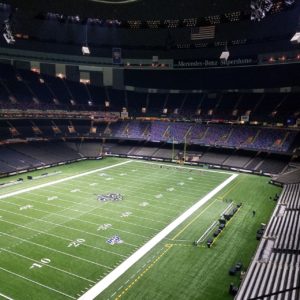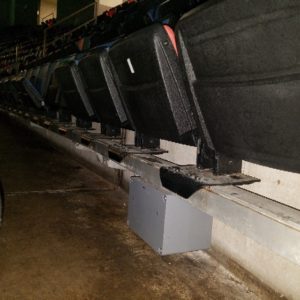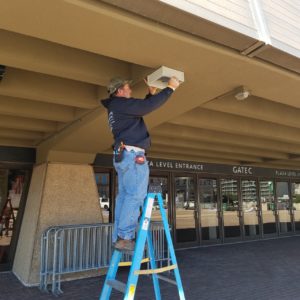
The Mercedes-Benz Superdome, home of Monday’s college football playoff championship game, has had a recent upgrade to its Wi-Fi network. Credit all photos: Mercedes-Benz Superdome.
Drive by the skyline-dominating Superdome at night, and you’ll see a three-point star projected on its façade. Known as the Mercedes-Benz Superdome since 2011, it’s more visual evidence of how New Orleans has fought its way back since Katrina tried to drown the city in 2005.
Inside the Superdome, a technology renewal has been in progress this past football season. New Wi-Fi access points have been installed; the venue’s IT managers don’t just want to deliver more bandwidth – they want to manage it intelligently and wring maximum return from their investment. Which helps explain why they’ve embraced under-seat APs throughout most of the Superdome, shedding the previous back-to-front/blast ’em with bandwidth approach that sporting venues once widely embraced.
“We pay attention to what the NFL needs, what the New Orleans Saints require and what the fans expect,” said Dave Stewart, a contractor working with ASM Global, (the entity that resulted from the September 2019 merger of Anschutz Entertainment Group and venue management firm SMG). “That’s why we make incremental improvements and as needs change, we want to be responsive.”
Keeping up with devices and demand
And wireless technology has evolved since the previous system was installed in 2012. While the number of smartphone users coming to the Superdome seven years ago was relatively low, they’re now the norm, Stewart said. “Year over year, take rates have increased, as have expectations and utilization,” he added. With more users and higher bandwidth consumption, the back-to-front deployment model struggled to keep up; Stewart and his colleagues started looking at other AP solutions like handrail encasements, under-seat APs, or some kind of hybrid.
The Superdome now features under-seat APs on its terrace level, with custom enclosures supplied by Airwae and is moving to under-seat APs in its lower bowl. For concerts or spectacles like Wrestlemania that require seating on what might otherwise be the Saints’ 50-yard line, ASM sets up folding chairs on the floor, and zip-ties AP enclosures beneath them. Cable runs between the APs and the network ports are never longer than 50 feet, Stewart explained.“Covering the floor is always difficult,” he added. “But deploying portable networks designed specifically for an event is something every multi-event venue must do.”
All told, the Superdome is up to 2,027 APs across the complex, which includes 410 newly installed APs in the lower bowl of the Superdome, all under seat. The upgrade is a sizeable increase from the previous 1,400 APs, which translates to approximately $7 million for the upgrade (Stewart wouldn’t divulge the exact amount). But he did say that physical infrastructure, cabling pathways and manpower account for 60 percent of a new install budget; 30 percent is typically hardware and licenses, and 10 percent goes to project management and design configuration.
Unlike most AP enclosures, those in the Superdome don’t rest on the ground; they’re bolted to the riser with about an inch of clearance at the bottom. Though most open-air venues power-wash their stands after an event, standing water doesn’t work inside the Superdome — moisture and its companions, rust and mold, are big issues. So Superdome officials procured an AP enclosure design that could be mopped under.
Keeping fans connected while they roam
Another aspect of the Superdome’s Wi-Fi installation is its focus on roaming, similar to the way cellular users get passed from antenna to antenna as they traverse an area. “We’ve designed Wi-Fi networks that onboard you, and the APs hand you off to the other APs,” Stewart explained. If users had to be re-associated with the Superdome’s Wi-Fi each time they activate their phone or move around the venue, that reduces airtime availability for them and the people around them, he added.
Regular Wi-Fi tuning is also essential to ensure efficiency and quality; the Superdome uses use Cisco’s adaptive radio management (ARM) to help tune and optimize its Wi-Fi for crowd sizes, event types and different locations around the dome. “We assign different power ranges and different channels or available sets of channels to each access point or group of APs,” Stewart said.The new APs have already spurred an uptick in connectivity and usage. Take rates are up to 70 percent with the under-seat APs according to Stewart. And about half of those users are actively uploading and downloading data, quadruple what he saw two or three years ago – and those numbers are climbing.
The Superdome is a Cisco shop; Stewart and his crew have been installing the vendor’s 4800 series APs and using the 802.11ac standard, also known as Wi-Fi 5. Next-generation APs, 802.11ax or Wi-Fi 6, are on Stewart’s radar and there’s a longer term transition strategy. While he sees Wi-Fi 6 as the future, he also knows the move will require a back-end upgrade, since legacy controllers don’t support an .ax solution.
“Since the pathway is such a high percentage of the cost, those AC enclosures will be re-useable,” Stewart said. The new enclosures are also designed to accommodate a larger cable size if needed.
Stewart likes the efficiencies that Wi-Fi 6’s OFDMA feature can wring out of the radio spectrum, coupled with its multi-user scheduling of the same frequencies, all of which will make a big impact on airtime performance. But Wi-Fi 6 benefits won’t truly be realized until most user devices support the standard. Right now only a small handful of devices (including the Apple iPhone 11 line) support Wi-Fi 6.
But Stewart and his team have a carrot to motivate them toward Wi-Fi 6 APs. A couple carrots, in fact: The NCAA Men’s Final Four in 2022, then Super Bowl 58 in 2024 (the fourth time the dome will host the NFL championship). They’re looking to ensure the best fan experience possible and that means plentiful bandwidth and seamless connectivity.
Stewart said it will take about 18 months to start the Wi-Fi 6 design and procurement process; they expect to start the project in 24 months and have it completed a year later, well in time for the Super Bowl.
“Part of our strategy is to have phased upgrades year by year to stay relevant and improve the customer experience,” Stewart explained. “Digital menus, better DAS, better Wi-Fi – we have to be attentive to what our fans want and deliver it year after year.”


















